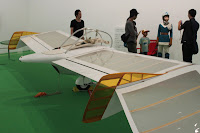Art and Air, the current exhibit at the Aomori Museum of Art chronicles artistic responses to the universal dream of flight as well as Japan's complex relationship with flying machines. It also provides a global perspective
that the typical tourist is not likely to encounter in Japan. Perhaps the most telling
piece of evidence to support this is the fact that none of the descriptions
beyond title are presented in English or any other language, which is most
unusual here. With the exception of a
fantastically whimsical display of theatrical backdrops that Marc Chagall did
for the New York City Ballet, this exhibit is of Japanese art, by Japanese
artists, for a Japanese audience.
 The only room in which photography is allowed is a display
of Open Sky 2.0, a fun piece of aeronautical art that actually flies using a
glider tow winch. The glider is
surrounded by walls of manga and video displays of the glider in flight.
The only room in which photography is allowed is a display
of Open Sky 2.0, a fun piece of aeronautical art that actually flies using a
glider tow winch. The glider is
surrounded by walls of manga and video displays of the glider in flight.
In my opinion, the strongest piece on display is “Returns”
(1996) by an artist whose name is not Romanized on the label. The painting depicts a swarm of Japanese
Zeroes flying in a Möbius
strip formation, infinitely strafing Manhattan.
The point of view is a fish-eye lens directly over the Empire State
Building. The concept is clever, the
execution flawless, the effect chilling.
I do not know how 9/11 might have altered the Japanese audience’s
response to this piece; I only know that it hangs on the wall in Aomori today.
 If our feelings of fear and outrage toward Nazi Germany’s aggressions
are captured in the image of a swastika-branded Stuka dive bombing a European city, and if our shock and dismay over Japan’s relentless determination can
be summarized in the image of a stricken Zero going kamikaze on a U.S. battleship, then Japanese disgust and animosity toward America is held in
the image of a B-29 Superfortress flying over Mt. Fuji. They really hate that plane here. In photographs, the plane appears smug and taunting; in
paintings, it is always crashing.
If our feelings of fear and outrage toward Nazi Germany’s aggressions
are captured in the image of a swastika-branded Stuka dive bombing a European city, and if our shock and dismay over Japan’s relentless determination can
be summarized in the image of a stricken Zero going kamikaze on a U.S. battleship, then Japanese disgust and animosity toward America is held in
the image of a B-29 Superfortress flying over Mt. Fuji. They really hate that plane here. In photographs, the plane appears smug and taunting; in
paintings, it is always crashing.
When the Land of the Rising Sun is backed into a corner, the
response appears to us as one of swarming.
In the first half of the 20th century we retaliated against Japan’s swarming
militaristic response to lack of natural resources; in the second half we
enjoyed her swarming industrial response to military strictures, which came to
us in the form of Hondas, Walkmans, and Trinitrons. Like us, Japan is trying to figure out some response
to the economic malaise we’re all suffering in the post-industrial 21st
century. Whatever form that response
takes, you can rest assured it will appear to us as a swarm, much like this installation
piece of origami airplanes strung on wires overhead:
For me though, the most thought-provoking piece is a huge display
of video images apparently shot from a Raptor drone. As I was unable to read the kanji
descriptions, I have to trust that the graphic of a drone set in a compass rose
showing its heading as it flies over Tokyo means that the video was actually
shot from a drone flying over the city.
As various landmarks come into view, the camera outlines each image as
though pattern recognition software is analyzing it and displaying geo-tagged
labels for that object. Occasionally the
camera zooms in on people—a man crossing a busy street, a couple kissing in a row
boat. Whether the images were actually
produced by an intelligent drone or are merely the artistic rendering of such
possibilities, the implications are clear: the next threat from the skies will
come in the form of tiny, unmanned aircraft that are operated remotely or,
worse, programmatically. That Mr. Obama
has so enthusiastically embraced this technology is my greatest disappointment in his foreign
policy; for others will follow his lead, and we are not going to like the
result, whether it's paparazzi drones with cameras or terrorist drones with warheads.
Didn’t anybody read Islands
in the Net?



No comments:
Post a Comment